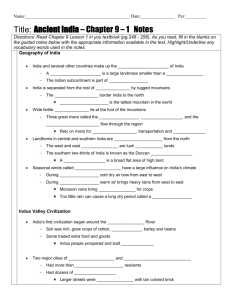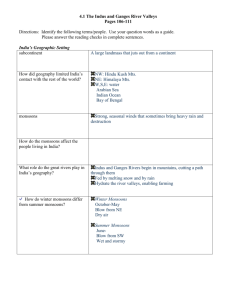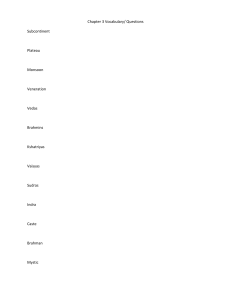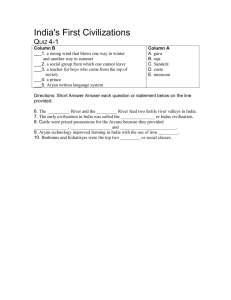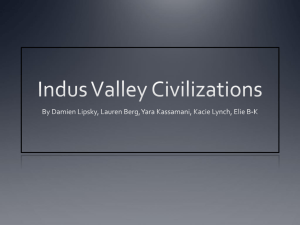Early Civilizations in India
advertisement
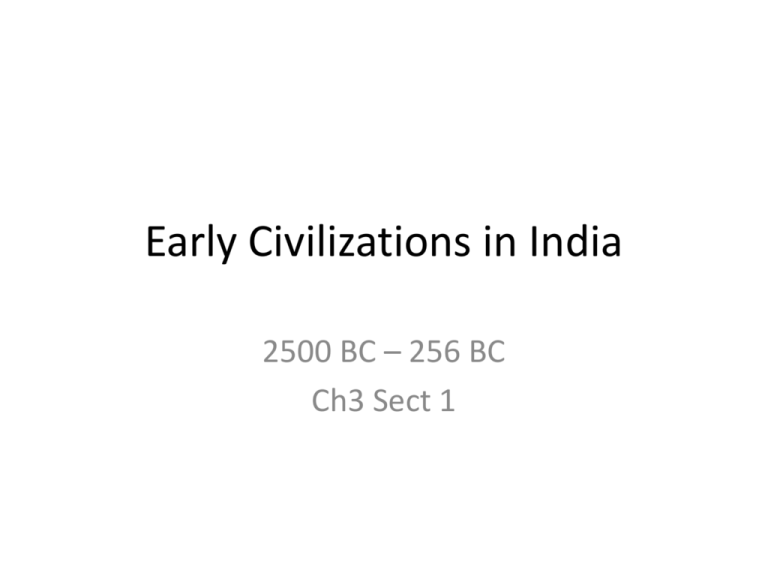
Early Civilizations in India 2500 BC – 256 BC Ch3 Sect 1 Geography of Indian Subcontinent • Subcontinentlarge landmass that juts out from a continent • 3 of world’s 10 most populous countries- India, Pakistan, and Bangladesh Northern Plain • Fertile region due to Indus, Ganges, and Brahmaputra Rivers • Carry melting snow from mountains to the plains making agriculture possible • Rivers are sacred to Indian people Mountains caused Indian people and culture to remain isolated Himalaya Mountains Deccan • Triangular plateau- raised level of land • Most of area is arid, unproductive, and sparsely populated Coastal Plains • Small rivers and seasonal rains provide area with water for farming • Eastern and Western Ghats • Monsoon- seasonal wind • October, winter monsoons blow from NE and bring hot, dry air that wither crops • June, wet summer monsoons blow from SW -pick up moisture from Indian Ocean and drench land with daily downpours • If rains are late, famine may occur but if rains are early deadly floods occur Indus Valley Civilization • Emerged in Indus River valley about 2500 BC. Flourished about 1000 years and vanished • Harappa and Mohenjo-Daro (moh HEHN joh Dah roh) twin capitals possibly • Along Indus River, 3 miles in circumference, huge warehouses for grain, and a fortress • Laid out in grid pattern, houses built of oven-fired clay brick, modern plumbing, baths, drains, water chutes, sewers beneath streets. • Uniform weights and measures Harappa Government • Well organized, powerful leaders, possibly priestkings, made sure all had steady supply of food • Buildings suggest government planners • Had to have mathematical skills to put together Farming and Trade • Most Indus Valley people were farmers • First to cultivate cotton and weave into cloth • Area close to Arabian Sea and Persian Gulf so easily reach Sumer. Contact caused system of writing to be born • Cuneiform shows no relationship to Sumer • Traded cotton, grain, copper, pearls, and ivory Religion • Polytheistic • Mother goddess, source of creation • Sacred bulls that later influenced veneration, or special regard for, cattle Disappearance • Indus Valley cities were declining. Standards not as good, pottery turned crude • Too many trees cut down, volcanic eruption blocked Indus which flooded city, devastating earthquake?!?!?! 1500 BC • Aryans migrated here and overran the Indus region as well Kingdoms of the Ganges Aryan Civilization • Somewhat nomadic • Only know what Vadas tells us, collection of prayers and hymns. 1500BC-500BC Vedic Age • Warriors who fought in chariots, loved eating, drinking, and music Expansion and Change • Aryan tribes led by rajahs- chief, most skilled warrior, elected by people • Eventually tribes settled down and learned farming and spread out around Ganges River, 800 BC • 500 BC new Indian civilization emerged consisting of many rival kingdoms due to acculturationblending of two or more cultures Aryan Groups • Divided people by occupation • Brahmins- priests Kshatriyas (kuh shat ree yuhz)- warriors Vaisyas (vis yuhz)- herders, farmers, artisans, merchants Sudras- Dravidians (people they conquered) and non-Aryans) farm workers, servants; lowest level of society • (dalits- considered outside the caste system) • Eventually gave rise to caste system, social group born in to and can’t change Aryan Religion • Polytheistic- gods embodied natural forces • Brahmins could call on gods for health, wealth, and victory in war • Move towards worshiping brahman- single spiritual power beyond the gods • Also move towards mystics- people who devote life to seeking spiritual truth • Sanskrit- written language that priests used to write down sacred texts • Mahabharata- India’s greatest epic, 100,000 verses. Aryan tribes fighting for Ganges. 5 royal brothers, Pandavas, lose area to cousins but take back after huge battle. Discusses Indian religious beliefs, immortality of the soul, and importance of duty Literature • Ramayana- Rama’s bride Sita is kidnapped by demon-king Ravana and story it all about Rama getting his bride back • Stories evolved over time and different morals come from them like role models and loyalty

